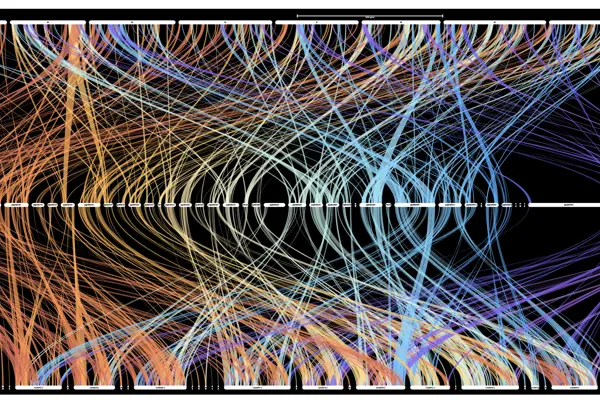

Bioinformatics
Bioinformatics applies high performance computing (HPC), programming and statistics to analyse very large biological data sets and distil meaningful and useful information from them. At RBGV Bioinformatics, we analyse DNA and RNA sequences from plant and fungal genomes, metagenomes, and transcriptomes, to answer research questions in evolution, ecology, and molecular biology.
Methods and Resources
RBGV Bioinformatics uses state-of-the-art computing resources to analyse data. Through Australian Biocommons and the ABLeS initiative, we have use of the NCI supercomputer Gadi, one of the most powerful computing resources in Australia. The RBGV also has capable in-house data storage and computing with a dedicated bioinformatics server.
RBGV Bioinformatics projects use the latest third-generation DNA sequencing technologies, such as PacBio HiFi, and Oxford Nanopore Technologies, which can obtain very long and accurate data to allow extraordinarily fast assembly of entire large genomes. We also apply Illumina sequencing technologies as a cost-effective solution to projects with very large sample numbers and targeted sequences.
Staff
Dr Chris Jackson
Dr Theo Allnutt
Links
RBGV GitHub
Theo Allnutt GitHub
Chris Jackson GitHub
HybPiper GitHub
Selected Recent Publications
Jackson CJ, McLay TG, Holmes GD, Allnutt TR, Robinson AS. (2025) A high quality genome of the common swamp pitcher plant (Nepenthes mirabilis) using PacBio HiFi sequencing. PLoS One, 20(7):e0322885.
Zuntini AR, Carruthers T, Maurin O, Bailey PC, Leempoel K, Brewer GE, et al. (2024) Phylogenomics and the rise of the angiosperms. Nature, 629(8013):843–50.
Jackson, C., McLay, T., Schmidt-Lebuhn, A.N. (2023) hybpiper-nf and paragone-nf: Containerization and additional options for target capture assembly and paralog resolution. Appl Plant Sci. 11 (4):e11532. doi: 10.1002/aps3.11532
McLay. T.G.B., Murphy, D.J., Holmes, G.D., Mathews S, Brown GK, Cantrill, D.J., Udovicic, F., Allnutt, T.R., Jackson, C.J. (2022). A genome resource for Acacia, Australia's largest plant genus. PLoS One.17 (10):e0274267. doi: 10.1371/journal.pone.0274267
McLay, T.G.B., Birch JL, Gunn, B.F., Ning, W., Tate, J.A., Nauheimer, L., Joyce, E.M., Simpson, L., Schmidt-Lebuhn, A.N., Baker, W.J., Forest, F., Jackson, C.J. (2021). New targets acquired: Improving locus recovery from the Angiosperms353 probe set. Appl Plant Sci. 9 (7):10.1002/aps3.11420. doi: 10.1002/aps3.11420
Syme A.E., McLay T.G.B., Udovicic. F., Cantrill. D.J., Murphy D.J. (2021) Long-read assemblies reveal structural diversity in genomes of organelles - an example with Acacia pycnantha. GigaByte. 2021 Dec 20;2021:gigabyte36. doi: 10.46471/gigabyte.36.
Davoodian, N., Jackson, C.J., Holmes, G.D., Lebel, T. 2020. Continental‐scale metagenomics, BLAST searches, and herbarium specimens: The Australian Microbiome Initiative and the National Herbarium of Victoria. Applications in Plant Sciences 8(9), e11392. doi: 10.1002/aps3.11392

